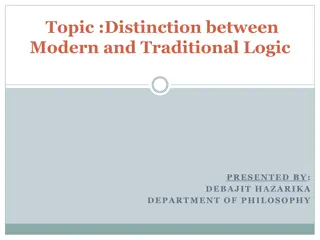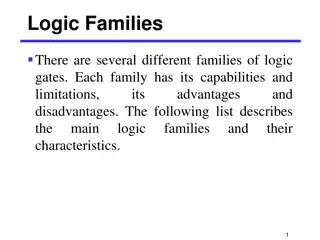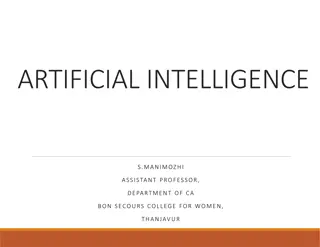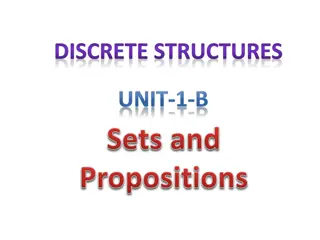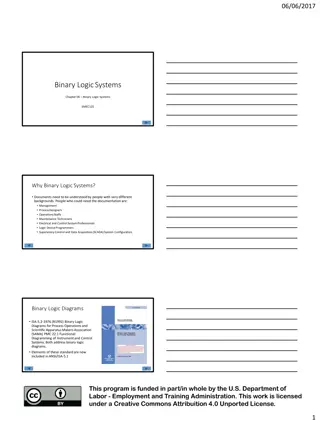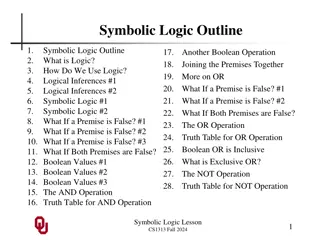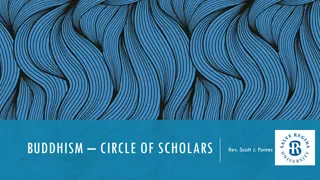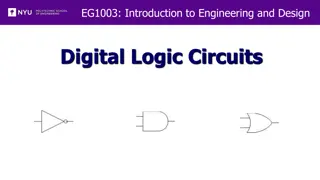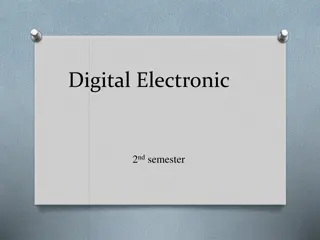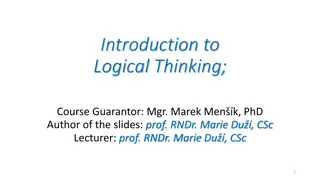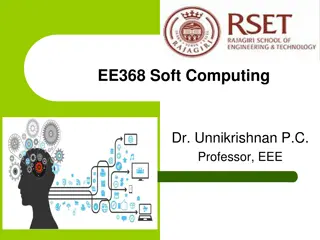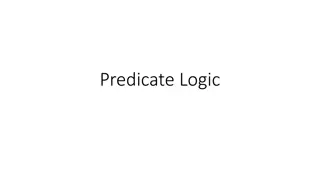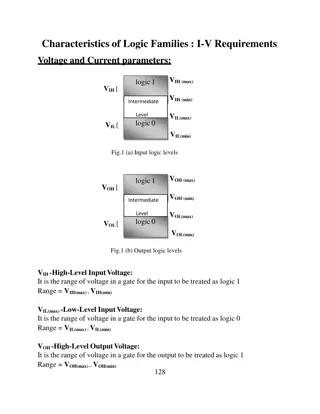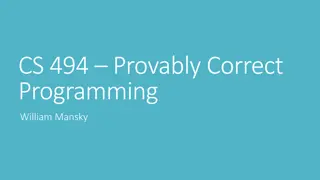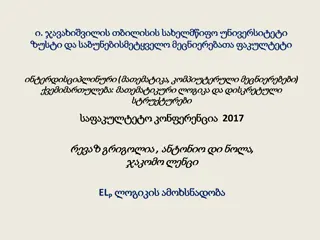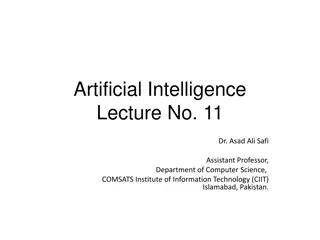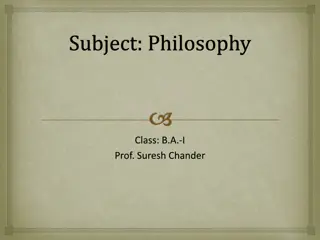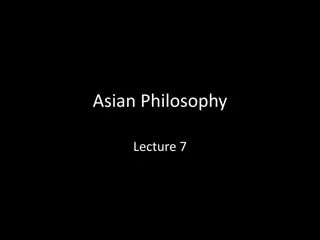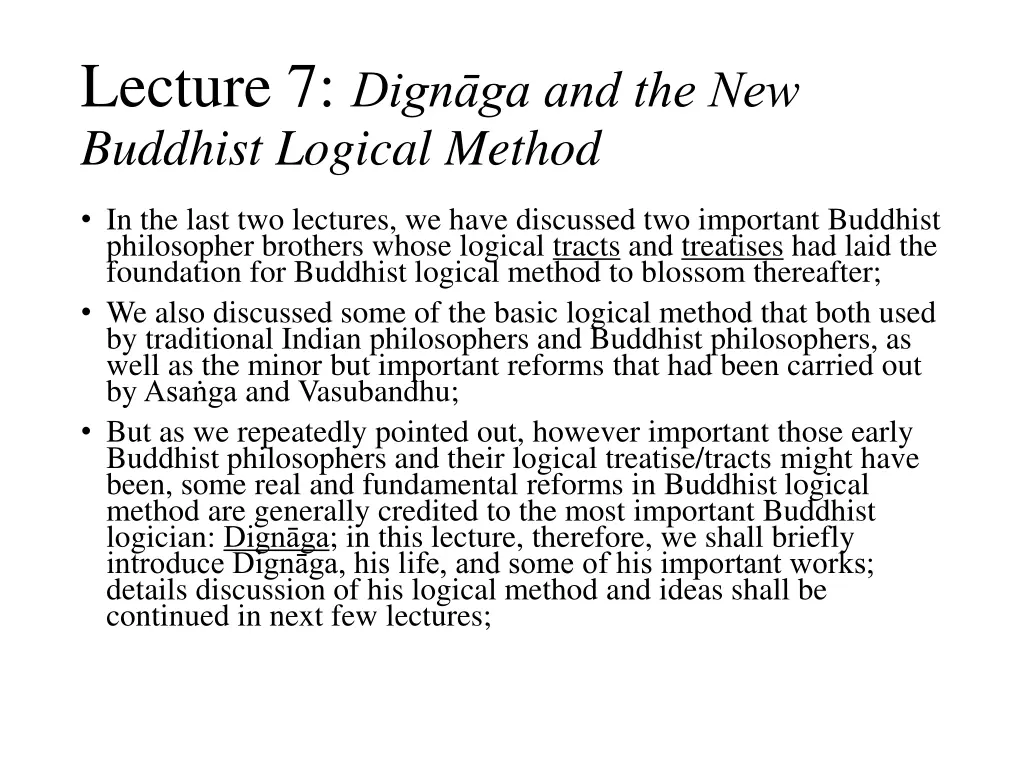
Dignga and the Evolution of Buddhist Logical Method
Explore the contributions of Dignga, a key Buddhist logician, in revolutionizing Buddhist logical methods. Learn about his life, works, and the foundational reforms he introduced. Discover the philosophical anecdotes and inquiries that shaped Dignga's approach to logic.
Download Presentation

Please find below an Image/Link to download the presentation.
The content on the website is provided AS IS for your information and personal use only. It may not be sold, licensed, or shared on other websites without obtaining consent from the author. If you encounter any issues during the download, it is possible that the publisher has removed the file from their server.
You are allowed to download the files provided on this website for personal or commercial use, subject to the condition that they are used lawfully. All files are the property of their respective owners.
The content on the website is provided AS IS for your information and personal use only. It may not be sold, licensed, or shared on other websites without obtaining consent from the author.
E N D
Presentation Transcript
Lecture 7: Dignga and the New Buddhist Logical Method In the last two lectures, we have discussed two important Buddhist philosopher brothers whose logical tracts and treatises had laid the foundation for Buddhist logical method to blossom thereafter; We also discussed some of the basic logical method that both used by traditional Indian philosophers and Buddhist philosophers, as well as the minor but important reforms that had been carried out by Asa ga and Vasubandhu; But as we repeatedly pointed out, however important those early Buddhist philosophers and their logical treatise/tracts might have been, some real and fundamental reforms in Buddhist logical method are generally credited to the most important Buddhist logician: Dign ga; in this lecture, therefore, we shall briefly introduce Dign ga, his life, and some of his important works; details discussion of his logical method and ideas shall be continued in next few lectures;
Preliminary remarks As we have already discussed, the traditional and Buddhist logical employed the 5 steps/members to infer what might be happening from what is happening; for instance, because of some smoke, the inference concludes that there must be some fire; the reason or explanation is that because fire and smoke generally take place together and almost at the same time; The reason is then backed up by the example of a kitchen, where when woods are burning to cook food, smoke emerges constantly; but with a different example, it is excluded that unlike a lake where there would be neither smoke nor fire; the reason is more than obvious: the opposing nature of water and fire/smoke; This is quite convincing but one question remains: if fire and smoke can be inferred from each other, and for that matter, sound and its being impermanent can be inferred from its being produced; then, are there any underpinning rules that might be applied more broadly to other cases? That is precisely the issues that Dign ga started to ask and quite satisfactorily answered;
How do you know? we shall start this lecture with a philosophical anecdote which may spare us from the otherwise boring terms and concepts of Buddhist logic; this is a rather amusing story so I hope you enjoy reading it and thinking about it afterwards: One day, Hui Shi (a ancient Chinese thinker lived around the 3rdcentury BCE, slight later than Aristotle) and Zhuangzi were wandering across the embankment of Hao River. Seeing some fish in the river, Zhuangzi pointed at the fish and said: look! How happy those fish must be! Hearing this, Hui Shi replied: since you are not a fish, how could you possibly know whether or not they are happy? Undeterred, Zhuangzi replied: yes, I am not a fish. But you are not me. How on earth could you possibly know that I do not know those fish are happy? Hui Shi, equally undeterred, asked again: sure, I am not you so I could not possibly know you (and your mind). But then, you are not a fish, so naturally you could possibly know fish (and the emotional state of the fish happy or not happy). The above philosophical anecdote is interesting, because it begs the question: how do we know something we do not know? And how certain?
Zhuangzi and Hui Shi: the debate! Zhuangzi Hui Shi Look, how happy those fish must be You are not fish. How do you know? You are not me, how do you know I do not know those fish are happy? But then, you are not me, how do you know I do not know you do not know? Now, lest us go back to the origin of the contentious point. Shall we? By all means, let s
Inference: let go back to the beginning The above conversation can continue like a infinity, because the sentence here is this: how do you know I do not know that I you do not know I do not know that you do not know I do not know The reason is simple: no one knows each other; But Zhuangzi then changed his tactic, saying that, since Hui Shi asked: how statement already i implies knew although Zhuangzi does not say how are happy, he told Hui Shi that by standing at the river embankment, he knew Here, we might as well remember the Buddhist and traditional Indian means of knowledge inference or logical reasoning, such as fire and smoke analogy; the same may be applied to the fish; how do you know those fish are happy, such a mplies that Hui Shi knew knew those fish are happy; the question here is how Hui Shi knew Zhuangzi how he came to know those fish knew those fish are happy; Zhuangzi how;
The original question: Zhuangzis point is not very convincing, but he raised a very important epistemological issue: how can we know and to what extent can we be certain that what we know is true and not false. Let us see the diagram below: Zhuangzi Hui Shi That is correct. You said that you are not fish, how do you know they are happy ? Here, we have two points: knowledge of happy fish and how. All right? But you accepted the fact that I knew the fish are happy. You just wanted to know how I came to know it the fish are happy. Sounds all right for me. That sounds all right, although without knowing how, I am still suspectable as to how can you possibly knew it fish are happy.
Possible ways of knowing fish and their happiness: we can certainly try the traditional Indian and Buddhist means of knowledge; as we have discussed so far, the inference method logical reasoning is used to infer unknowns from known things; for instance, from the sign of smoke and then from the invariable concomitance between smoke and fire, the existence of fire in a mountain far away could be inferred. Below is the application of that method: Swimming and jumping Similar human emotional expressions Physical illustration of happiness: movements and gestures Reasoning and inferring Fish & their expression of happiness which can be compared with human emotions or human expressions of happiness and joyfulness
Possible 5-membered/stepped inference process: please remember that below is just a simple attempt of application of the Buddhist inference method; we just want to illustrate the strong point and the weak point in the Buddhist logical reasoning method before and after Dign ga; Like kids, happily jumping, unlike cats, lazily sleeping The fish must be happy They must happy Because they are swimming and jumping The fish are jumping and swimming
Can we be so sure? The above logical reasoning is the classical method used as ways of inference, deduction or induction. But the obvious question is can we be sure or certain? In other words, is the conclusion is guaranteed by its premise or premises? The answer cannot be straightforwardly answered: as we mentioned, in deductive logical reasoning, it is necessary that the conclusion is deduced from its premise/s so the corollary between the premises and the conclusion is certain; but in inductive logical reasoning, the outcome or conclusion is probable. In other words, it means that there is a high probability that the premise or premises entails or entail the conclusion, although that is not necessarily guaranteed. For example, we may compare the similar patterns between the expressions of happiness and joyfulness between fish and human beings, although that is by no means certain that our comparison would guarantee the conclusion and its validity and truth value. It would be probably true but can be false as well. That has been one of the concerns of Buddhist logicians such as Asa ga and Vasubandhu; but it was Dign ga who address most of the issues;
Dignga: founder of new Buddhist logical reasoning As we mentioned in the last lecture, by the time of Dign ga s teacher, Vasubandhu, some awareness of the problem with the traditional logical method the 5-membered (5 steps, remember in this way may be easy for you to understand) logical method (the fire in the mountain, the smoke, and examples of kitchen and lake etc.; or the sound, produced-ness, and impermanent, and the examples of pot and sky). For example, we have pointed out that generally the method is sufficiently enough to infer one thing from another. But a close look at it also reveals that the last two members are repetitious; Furthermore, as we have showed in the previous slides, there are also some issues with the old-fashioned logical method, which in one way or another, rendered the method less effective and even less certain; that was precise what Dign ga had considered and fixed with his new logical ideas;
Importance of Dignga: Dignga is not only integrated all the previous insights of logical method, but also address some of the most important problems concerning traditional and Buddhist logical method; please note that the term hetuvidya (illuminating reason) was not invented by Dign ga; but ever since Dign ga and in particular in Buddhist tradition, hetuvidya (also known as new hetuvidya ) is used almost exclusively and thus virtually replaced the term ny ya; also, he integrated the means of knowledge (pram a) and the logical debate (v da) method into one consistent system, thus brought the logic and epistemology into one; (see Katsura, p.71)
Dignga: his life is difficult to know, although some details can be tentatively ascertained; he was born in Kanci, a small town in south India, probably lived around 5thcentury; he was a pupil of Vasubandhu, when the latter was the master (equivalent of modern day vice-chancellor of a university) of the earliest university in the world Nalanda Monastery;
Noticeable ideas: below are some noticeable ideas introduced by Dign ga into Buddhist logical method as well as Buddhist epistemology; we shall discuss some of them in details in the next few lecture so now just remember them; Although Vasubandhu dropped the last two members of the 5- membered logical method, it was Dign ga perfected the system and fixed it into a 3-membered logical method/sequent; Also, he further developed Vasubandhu s idea of invariable concomitance by introducing the new idea vy pti, which means pervasion, i.e. between the thesis (probans that which is to be proven) and the reason (probandum proof or that which proves); He also invented the idea apoha, which means exclusion; this idea casts great insights on the Buddhist idea of language; for instance, we generally understand that if we refer to an elephant by a concept and a mental image of the animal; but Dign ga suggested instead of perceiving the concept and the properties of an elephant, such as big animal with long tusks, we exclude those animals that are not elephant, such as a cow or a buffalo;
Vypti: this is an important concept that almost exclusively enhanced the validity and cogent level of Buddhist logical method; we shall discuss it in detail in next lecture; but here, just remember by considering the diagram below: through the second gear (reason), a relationship between the first and the third gears could be established; but that relationship is meaningless unless a pervading relationship can be established between the first gear (thesis) and the second gear (reason); so when the first gear moves, the second would follow, thus triggering the movement of the third gear and the whole chain of gears; the inevitable gearing up relationship between the thesis and the reason can be understood as vy pti or pervasion;
Trairpya: this is another important idea developed by Dign ga in terms of reason or sign; again, here we just mention it and we shall discuss it in detail in the next few lectures; Trair pya means three characteristics of the reason or sign; as we have mentioned, while Vasubandhu only dropped the last two members of the 5-membered logical method because they are apparently redundant, Dign ga not only reformed them but also went further by perfecting the system with new definitions; One of the steps he took was to clarify the three remaining members/terms, and in particular, he redefined their relationship; thus he came up the idea of trair pya or the three characteristics; 1, That of vy pti or the pervading association between the thesis and the reason/sign; 2, That the property of the reason must be present in the similar example; 3, That the property of the reason must be absent in the dissimilar example; By the above clarification, through the newly reformed Buddhist logical method/sequent, the validity and cogent level are greatly enhanced;
Trairpya: below is a simple diagram to illustrate the subtle relationship between the thesis, the reason and the example; more detailed discussions will be provided in due course;
Summary and facts check In this lecture, we explained the possible problems in traditional Indian and Buddhist logical reasoning inference by way of a philosophical anecdote; Although early Buddhist philosophers such as Asa ga and Vasubandhu already noticed those issues, and in fact they started to provide some solutions; but it was Dign ga who for the first time address all the concerning issues in a very systematic way; Basically, Dign ga reformed three aspects of the traditional logical method which are crucially important: fixation of the 3-membered method, definition of the vy pti, and the invention of trair pya; We also mentioned that the concept apoha, which is also a very important development by Dign ga, but that term is more related to philosophy of language; we shall discuss this in due course; That should be all for this week; any questions, let me know!
Exercises #7 Do the following exercises and submit them via email (chuanqing@bcs.edu.sg) to me by 5:00 pm, on 14thOctober (Wednesday); as usual, please send the exercises of the two courses (Buddhism and Economics & Introduction to Buddhist Logic) together in one Word doc. file; 1, Who is Dignaga? Just answer who is he and what did he do would be enough; 2, Write down two important ideas about Buddhist logic developed by Dignana;

